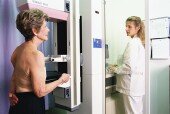
FRIDAY, April 19 (HealthDay News) — More than three years after controversial new guidelines rejected routine annual mammograms for most women, women in all age groups continue to get yearly screenings, a new survey shows.
In fact, mammogram rates actually increased overall, from 51.9 percent in 2008 to 53.6 percent in 2011, even though the slight rise was not considered statistically significant, according to the researchers from Brigham and Women’s Hospital and Harvard Medical School.
“There have been no significant changes in the rate of screening mammograms among any age group, but in particular among women under age 50,” said the study leader, Dr. Lydia Pace, a global women’s health fellow in the division of women’s health at Brigham and Women’s.
While the study did not look at the reasons for continued screening, the researchers speculated that conflicting recommendations from various professional organizations may play a role.
In 2009, the U.S. Preventive Services Task Force, an independent panel of experts, issued new guidelines that said women younger than 50 don’t need routine annual mammograms and those 50 to 74 could get screened every two years. Before that, the recommendation was that all women aged 40 and older get mammograms every one to two years.
The recommendations ignited much controversy and renewed debate about whether delayed screening would increase breast cancer mortality. Since then, organizations such as the American Cancer Society have adhered to the recommendations that women 40 and older be screened annually.
To see what effect the new task force recommendations have had, the researchers analyzed data from almost 28,000 women over a six-year period — before and after the new task force guidelines.
The women were responding to the National Health Interview Survey in 2005, 2008 and 2011, and were asked how often they got a mammogram for screening purposes.
Across the ages, there was no decline in screenings, the researchers found.
Among women 40 to 49, the rates rose slightly, from 46.1 percent in 2008 to 47.5 percent in 2011. Among women aged 50 to 74, the rates also rose, from 57.2 percent in 2008 to 59.1 percent in 2011.
The study, supported by Brigham and Women’s Hospital, is published in the April 19 online edition of the journal Cancer.
Pace said conflicting recommendations from different organizations could have generated much confusion among both doctors and patients.
She added, “Another possibility would be that some providers and patients would simply be in disagreement [with the task force recommendation].”
In the 2009 recommendations, the task force said women 40 to 49 should discuss the pros and cons with their doctor, then decide whether to get screened. The task force took into account the lower incidence of breast cancer in younger women, as well as the downsides of screening, such as false positives, in which cancer is suspected but not found. False positives can lead to unnecessary testing, expense and emotional strain, experts say.
But even if a woman’s doctor advises reducing the number of mammograms or waiting until age 50, “patients can self-refer for mammography,” Pace said.
“It’s an emotionally charged decision for women and doctors as well,” she added.
“I’m not surprised by this,” said Dr. Joanne Mortimer, co-director of the breast cancer program at the City of Hope Comprehensive Cancer Center, who reviewed the findings.
She, too, speculated there could be many reasons behind the findings. “It takes years for doctors to change their practice,” she said, adding that many doctors may still not be comfortable with the new guidelines.
Doctors could also be reluctant to suggest delayed screenings for younger women or expanding the interval between tests for older women, Mortimer added, because of fears of possible lawsuits if a cancer goes unnoticed.
Insurers have not looked to the task force recommendations as a reason to drop coverage for mammograms, both Mortimer and Pace noted.
And screening mammograms every one to two years are due to be covered, without expense, as a preventive care service under the Affordable Care Act for women over 40.
The task force aims to review each medical topic every five years, according to a spokesperson. By that schedule, screening mammogram recommendations would be due for a re-evaluation in 2014.
More information
To learn more about mammograms, visit the American Cancer Society.

